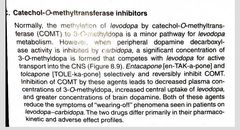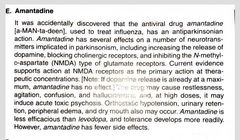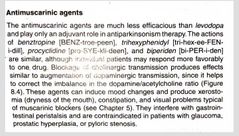![]()
![]()
![]()
Use LEFT and RIGHT arrow keys to navigate between flashcards;
Use UP and DOWN arrow keys to flip the card;
H to show hint;
A reads text to speech;
18 Cards in this Set
- Front
- Back
|
Parkinson disease Vs Alzheimer disease |
1. Parkinson disease - pathology of the Negrostraital pathway, a pathway around the basal ganglia 2. Alzheimer disease - widespread destruction of cholinergic neurons around the cortex, esp to the renshaw cells |
|
|
What is bradykinesia |
Slowness in initiating and carrying out voluntary movement .. |
|
|
Characteristics of Parkinson disease |
1. Bradykinesia 2. Muscle rigidity 3. Tremors - resting tremor 4. Hypokinesia ( inability to initiate voluntary movement ) 5. Dyskinesia ( uncoordinated involuntary movement ) 6. Postural and gait abnormalities. |
|
|
Secondary parkinsonism / pseudoparkinsonism |
1. Phenothiazines 2. Haloperidol Major action is blockade of Dopamine receptors in the brain, may result in parkinsonian symptoms.. These drugs should be used with caution in patient with Parkinson disease.. |
|
|
Aim of treatment of Parkinson disease |
Is aimed at 1. restoring dopamine in the basal ganglia and 2. Antagonizing the Excitatory effect of cholinergic neurons, thus reestablishing the correct dopamine / Acetylcholine balance.. |
|
|
Symptoms of overriding effect of Ach |
1. Spasity ( spastic gait) 2. Wackling of the tongue, affecting speech 3. Drooling of saliva |
|
|
What is the on - off phenomenon |
Because levodopa has an extremely short half life, plasma levels may drop suddenly. This may cause sudden immobility, tremors and cramps. The development of rapid changes in clinical response to the drug is known as the on - off phenomenon.. |
|
|
Dopamine hydrolase Vs decarboxylase |
1.Dopamine hydrolase - metabolizes Dopamine, so Dopamine does not cross the BBB 2. Dopamine decarboxylase - converts levodopa to dopamine |
|
|
Drug interactions of levodopa - drugs not given with levodopa |
1. Pyridoxine - increases peripheral breakdown of the drug 2. MOA inhibitor - |
|
|
About selegeline 1. Class 2. MOA 3. Metab |
1. MAO, type B inhibitor 2. MOA - it is selective at recommended doses( does not inhibit MAO, type A inhibitor that metabolize NE, 5-HT) .. By decreasing dopamine metab, it increases Dopamine level in the brain. It enhances the actions of levodopa and substantially reduces the required dose. 3. Selegeline is metab to methamphetamine and amphetamine whose stimulating properties may produce insomnia if the drug is administered later than mid afternoon. |
|
|
Examples of MAO type B inhibitor |
1. Selegiline 2. Rasagiline Rasagiline is an irreversible and selective inhibitor of brain MAO type B, has potency 5 times of Selegiline. Unlike Selegiline, Rasagiline is not metabolized to amphetamine - like substance |
|
|
List COMT inhibitors plus MOA |

1. Entacapone 2. Tolcapone |
|
|
Dopamine receptor agonists / dopamine analogue - list them |
1. Bromocriptine ( ergot derivative) 2. Non ergot drug a. Ropinirole b. Rotigotine c. Pramipexole D. Apomorphine |
|
|
Bromocriptine, Pramipexole and Ropinirole are effective in patient who? |
Who have Parkinson's disease complicated by motor fluctuation and Dyskinesias . However, are ineffective on patient who have not responded to levodopa. Apomorphine is an Injectable Dopamine agonists that is used in severe and advanced stages of the disease to supplement oral medications |
|
|
About Apomorphine use |
Apomorphine is an Injectable Dopamine agonists that is used in severe and advanced stages of the disease to supplement oral medications |
|
|
Because Bromocriptine is an Ergot alkaloid, 1. it can cause? 2. Worsen? 3. Used with caution with? |
1. Pulmonary fibrosis and retroperitoneal fibrosis. Bromocriptine may worsen psychiatric , mental condition. Used in caution - in patient with hx of MI, or peripheral vascular disease |
|
|
Amantidine and Parkinson disease 1. Class of drug 2. MOA 3. S/E |

|
|
|
Anti cholinergic / Muscarinic drugs and Parkinson disease |

|

